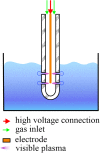Inactivation of Pepper Mild Mottle Virus in Water by Cold Atmospheric Plasma
- PMID: 33584622
- PMCID: PMC7877120
- DOI: 10.3389/fmicb.2021.618209
Inactivation of Pepper Mild Mottle Virus in Water by Cold Atmospheric Plasma
Abstract
Water scarcity is one of the greatest threats for human survival and quality of life, and this is increasingly contributing to the risk of human, animal and plant infections due to waterborne viruses. Viruses are transmitted through polluted water, where they can survive and cause infections even at low concentrations. Plant viruses from the genus Tobamovirus are highly mechanically transmissible, and cause considerable damage to important crops, such as tomato. The release of infective tobamoviruses into environmental waters has been reported, with the consequent risk for arid regions, where these waters are used for irrigation. Virus inactivation in water is thus very important and cold atmospheric plasma (CAP) is emerging in this field as an efficient, safe, and sustainable alternative to classic waterborne virus inactivation methods. In the present study we evaluated CAP-mediated inactivation of pepper mild mottle virus (PMMoV) in water samples. PMMoV is a very resilient water-transmissible tobamovirus that can survive transit through the human digestive tract. The efficiency of PMMoV inactivation was characterized for infectivity and virion integrity, and at the genome level, using test plant infectivity assays, transmission electron microscopy, and molecular methods, respectively. Additionally, the safety of CAP treatment was determined by testing the cytotoxic and genotoxic properties of CAP-treated water on the HepG2 cell line. 5-min treatment with CAP was sufficient to inactivate PMMoV without introducing any cytotoxic or genotoxic effects in the in-vitro cell model system. These data on inactivation of such stable waterborne virus, PMMoV, will encourage further examination of CAP as an alternative for treatment of potable and irrigation waters, and even for other water sources, with emphasis on inactivation of various viruses including enteric viruses.
Keywords: cold atmospheric plasma; enteric viruses; pepper mild mottle virus; virus inactivation; water decontamination.
Copyright © 2021 Filipić, Dobnik, Tušek Žnidarič, Žegura, Štern, Primc, Mozetič, Ravnikar, Žel and Gutierrez Aguirre.
Conflict of interest statement
The authors declare that the research was conducted in the absence of any commercial or financial relationships that could be construed as a potential conflict of interest.
Figures





Similar articles
-
Role of pepper mild mottle virus as a tracking tool for fecal pollution in aquatic environments.Arch Microbiol. 2022 Jul 22;204(8):513. doi: 10.1007/s00203-022-03121-3. Arch Microbiol. 2022. PMID: 35864362 Free PMC article. Review.
-
Suitability of pepper mild mottle virus as a human enteric virus surrogate for assessing the efficacy of thermal or free-chlorine disinfection processes by using infectivity assays and enhanced viability PCR.Water Res. 2020 Nov 1;186:116409. doi: 10.1016/j.watres.2020.116409. Epub 2020 Sep 10. Water Res. 2020. PMID: 32942179
-
Enteric Viruses and Pepper Mild Mottle Virus Show Significant Correlation in Select Mid-Atlantic Agricultural Waters.Appl Environ Microbiol. 2021 Jun 11;87(13):e0021121. doi: 10.1128/AEM.00211-21. Epub 2021 Jun 11. Appl Environ Microbiol. 2021. PMID: 33893119 Free PMC article.
-
Applicability of pepper mild mottle virus and cucumber green mottle mosaic virus as process indicators of enteric virus removal by membrane processes at a potable reuse facility.Water Res. 2021 Nov 1;206:117735. doi: 10.1016/j.watres.2021.117735. Epub 2021 Oct 3. Water Res. 2021. PMID: 34673461
-
Pepper mild mottle virus: A plant pathogen with a greater purpose in (waste)water treatment development and public health management.Water Res. 2018 Nov 1;144:1-12. doi: 10.1016/j.watres.2018.06.066. Epub 2018 Jun 30. Water Res. 2018. PMID: 30005176 Free PMC article. Review.
Cited by
-
Leveraging Plasma-Activated Seawater for the Control of Human Norovirus and Bacterial Pathogens in Shellfish Depuration.Foods. 2024 Mar 11;13(6):850. doi: 10.3390/foods13060850. Foods. 2024. PMID: 38540842 Free PMC article.
-
Nitric-oxide enriched plasma-activated water inactivates 229E coronavirus and alters antiviral response genes in human lung host cells.Bioact Mater. 2023 Jan;19:569-580. doi: 10.1016/j.bioactmat.2022.05.005. Epub 2022 May 8. Bioact Mater. 2023. PMID: 35574062 Free PMC article.
-
Standards to support an enduring capability in wastewater surveillance for public health: Where are we?Case Stud Chem Environ Eng. 2022 Dec;6:100247. doi: 10.1016/j.cscee.2022.100247. Epub 2022 Aug 15. Case Stud Chem Environ Eng. 2022. PMID: 37520917 Free PMC article.
-
Pepper Mild Mottle Virus: An Infectious Pathogen in Pepper Production and a Potential Indicator of Domestic Water Quality.Viruses. 2023 Jan 19;15(2):282. doi: 10.3390/v15020282. Viruses. 2023. PMID: 36851496 Free PMC article. Review.
-
Role of pepper mild mottle virus as a tracking tool for fecal pollution in aquatic environments.Arch Microbiol. 2022 Jul 22;204(8):513. doi: 10.1007/s00203-022-03121-3. Arch Microbiol. 2022. PMID: 35864362 Free PMC article. Review.
References
-
- Aboubakr H. A., Gangal U., Youssef M. M., Goyal S. M., Bruggeman P. J. (2016). Inactivation of virus in solution by cold atmospheric pressure plasma: identification of chemical inactivation pathways. J. Phys. D. Appl. Phys. 49 1–17.
-
- Aboubakr H. A., Sampedro Parra F., Collins J., Bruggeman P., Goyal S. M. (2020). Ìn situ inactivation of human norovirus GII.4 by cold plasma: ethidium monoazide (EMA)-coupled RT-qPCR underestimates virus reduction and fecal material suppresses inactivation. Food Microbiol. 85:103307. 10.1016/j.fm.2019.103307 - DOI - PubMed
LinkOut - more resources
Full Text Sources
Other Literature Sources
Miscellaneous

